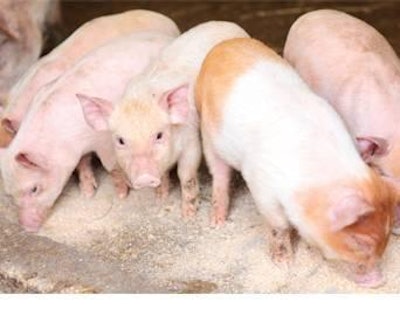
Fiber is an essential component of piglet diets, vital for optimal health and digestion. Some types of fiber have functional effects that assist in the maturation of the gut wall as well as influencing the gut microflora. Certain fibers are fermented by bacteria to produce short-chain fatty acids that can be used as an energy source by the piglet.
In contrast, inadequate fiber levels have a negative effect on gut health, including a higher incidence of diarrhea. Traditionally, fiber has been seen as the bad guy, reducing digestibility and nutrient availability, but not so anymore, especially when antibiotic-free diets are considered. Despite the positive effects and technologies available to alleviate many of the negative effects there is still some resistance to high(er) fiber levels, especially in countries that can still use in-feed antibiotics.
Types of fiber
Evaluation of crude fiber levels in raw materials is standard practice. Nevertheless, the term "functional fiber" is becoming more important. These functional fibers have a physiological or health benefit over and above their (positive or negative) nutritive value. Functional fibers are often considered to be those that have been specifically added as a health additive, but fibers present in wholesome materials can also play a similar role. In Table 1 the different types of fiber and their functional properties are listed.
Fiber can be described as either soluble or insoluble, with crude fiber values referring to the insoluble fraction. This includes the non-starch polysaccharides (NSPs) cellulose and hemi-cellulose, as well as lignin. Although not available to the animal, soluble NSPs are a food source for bacteria, favoring the beneficial ones. Even those that are not fermentable play a role in assisting digestive passage, absorbing excess water and increasing fecal bulk. However, the level of crude fiber in a diet will affect its digestibility.
Soluble fibers can be absorbed by pigs and include the NSPs xylan and beta-glucan; nevertheless, their energy-yielding capacity, once absorbed, is negligible. These fibers are usually associated with increased gut viscosity and reduced nutrient availability. Piglets are more susceptible to their negative effects than older animals. As their digestive systems are still developing post-weaning, feed conversion rate can be negatively affected by increased concentration of NSP fibers. However, in the case of beta-glucans, for example, immune supportive effects have been documented.
Finally, recent evidence indicates that thermal processing of common ingredients may cause sufficient modification to naturally existing fibers conferring additional functional properties.
Fiber and gut health
Gut health is key to piglet performance, health and development. Good and timely gut maturation means that feed efficiency can be optimized in the growing and finishing phases. Young animals with an immature immune system are also more vulnerable to pathogens. Weaning is a stress and the associated change in nutrient source is known to increase digestive upsets. Therefore, supporting the "good" bacteria in the gut can offer increased protection against disease and reduce the incidence of diarrhea.
A recent trial in weaned piglets evaluated the effects of fiber source on intestinal mucosal barrier function. The animals were fed fiber from maize, soybeans, wheat bran or peas; after 30 days, intestinal measurements were made (Table 2). Differences in intestinal morphology indicate that fiber from wheat bran and pea had a positive effect on gut maturity. These fiber sources also increased Lactobacillus counts in the ileum and Bifidobacterium counts in the colon. Toll-like receptor 2 (TLR2) gene mRNA levels were up-regulated in the ileum and colon of pigs fed wheat bran fiber. Fiber from wheat bran and pea improved the intestinal barrier function, meaning that piglets fed these diets had a greater level of protection against digestive disorders.
Concentrated sources of functional fibers
With all the difficulties in describing the amount and types of fiber in raw materials, would using a concentrated source as an additive be easier? There are several products on the market, which claim health and performance benefits for pigs. Combinations of fermentable and non-fermentable fibers are also available, offering prebiotic effects plus improvements in fecal quality. Many of these purified fiber products have been tested in vitro and in vivo to give pig producers confidence in their efficacy. On the other hand, certain raw materials already contain a varied profile of fibers, and at the end it becomes a matter of cost and convenience.
Functional fibers in a concentrated form do have the extra benefit of relatively low inclusion rates (0.1-2 percent), making it easy to find "room" in the diet or premix for them, without diluting nutrient levels. They are also consistent and will not require constant reformulation to get fiber levels right. This is especially important in the case of piglet diets.
Formulating for fiber
Fiber is essential in assisting the development of the gastrointestinal tract, which is key to managing piglet health and performance. With good reason there is a tendency to reduce fiber levels and use highly digestible raw materials in diets for piglets. However, not all fibers were created equal, and the benefits of including functional fibers could help producers’ bottom line. They can help to reduce the risk of post-weaning diarrhea and improve growth rates.
As with all nutritional concepts, their application must be tailored to producers’ particular situation. Ingredient availability and economics will affect the decision, as will production and housing types. The use of functional fibers may be particularly helpful in alternative or antibiotic-free systems. And as sustainability becomes more important, an understanding of how to make the most of often fiber-rich alternative raw materials will be key.

















